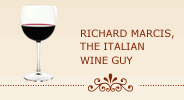Overlooked Gems in Rome Worth a Visit When Next in the Eternal City
Rome is a tourist’s delight. The city is a treasure-trove of historic landmarks, monuments, world-class museums and artwork that make it one of the most popular tourist destinations in the world. The Colosseum and the Roman forum, St. Peter’s and the Vatican Museums, Piazza Navona and the Trevi Fountains, just to name a few, are amazing places that receive millions of visitors a year.
But there’s also another Rome of less-well known monuments and historic treasures. But less-well-known doesn’t mean second rate - they can rival the more popular destinations in terms of architectural beauty and historic significance. For whatever reason they just don’t happen to be on most tourists’ radar screens.
Here are four of Rome’s overlooked gems that are well worth a visit when next in Rome especially for those with an abiding interest in art, architecture and history. Since visitors may find themselves in need of sustenance after touring, a few convenient wine-friendly restaurants are included with each of the four sites listed.
Church of St. Louis of the French (Chiesa di San Luigi dei Francesi)
Not far from Piazza Navona and Campo de Fiori in Rome is the Chiesa di San Luigi dei Francesi or Church of St. Louis of the French. This ornate church was built in the late 16th century and dedicated to Saint Louis IX, the king of France. It is the national church of France in Rome and has been the church for Rome’s French community since its completion in 1589.
The Church itself is a beautiful Baroque masterpiece and hosts many prized works of art including frescoes by Domenichino and an altarpiece by Guido Reni, among others. But the real gems are in the Contarelli Chapel of the church where three of Caravaggio’s most famous paintings are on display.
Think about that. Caravaggio was Italy’s most famous painter of the late 16th - early 17th centuries, famous for his large-scale, naturalistic and dramatic depictions of stories from the Bible. Any world-class museum would be proud to have just one of his paintings. This relatively small church has not just one or two but three canvasses by Caravaggio, and they are some of his best works. The three paintings focus on the life - and death - of Saint Matthew and include The Inspiration of Saint Matthew, the Calling of St Matthew (see left) and The Martyrdom of Saint Matthew.
Chiesa di San Luigi dei Francesi, Via S. Giovanna d’Arco, 5 Rome.
Nearby wine-friendly restaurants include:
Casa Bleve, Via del Teatro Valle, 48-49; phone: + 39-06-686-5970; website: http://www.casableve.com.
Located in the ornate, column-lined courtyard of a 16th century palazzo, this upscale wine bar-cum-restaurant has a deep wine list and an à la carte menu of Italian specialties. This is one of Rome’s best wine and dine experiences.
Armando al Pantheon, Salita dei Crescenzi, 31; phone: +39-06-6880-3034; website: www.armandoalpantheon.it.
In the shadow of the Pantheon, this old-style family trattoria serves up simple pastas and Roman classics in a cozy environment.
Basilica of St. Peter in Chains (Basilica di San Pietro in Vincoli)
The Basilica of St. Peter in Chains in central Rome is named after the chains that bound St. Peter when he was imprisoned in Jerusalem and later in Rome. It’s a complicated story but the short version is that Eudoxia, wife of Emperor Valentinian III, brought the chains that reputedly held St. Peter while he was imprisoned in Jerusalem to Rome in the fifth century and then 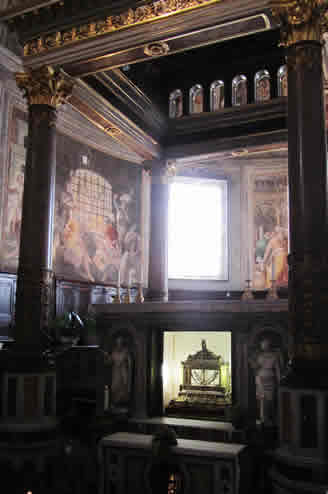 subsequently gifted the chains to Pope Leo I who placed them in this church where they are now on display in a dazzling gold reliquary in front of the church’s high altar.
subsequently gifted the chains to Pope Leo I who placed them in this church where they are now on display in a dazzling gold reliquary in front of the church’s high altar.
As interesting as the chains may be, the Basilica, however, is probably better known for the statue of Moses that Michelangelo carved for the tomb of pope Julius II that is prominently displayed in the church.
In 1505, pope Julius II asked Michelangelo to come to Rome to design and execute work on his tomb. Although no drawings of his original design survive, it is thought that Michelangelo planned a huge, three-tiered marble monument with 40 statues that included those of Christ, Moses and pope Julius II, among others.
However, because Michelangelo was frequently pulled away for other engagements work on the tomb progressed intermittently. When the Pope died shortly after the completion of the Sistine Chapel, interest in his tomb project waned and it was never completed. At Michelangelo’s death in 1564 only the statues of Moses and a few other figures had been completed.
But what affecting statues they are. The statue of Moses with its large size, craftsmanship and exquisite detail is powerful, a Michelangelo masterpiece. It is said that Michelangelo himself considered the Moses statue to be one of his best works. Moses’ head is sculpted with a pair of horns that are supposed to repre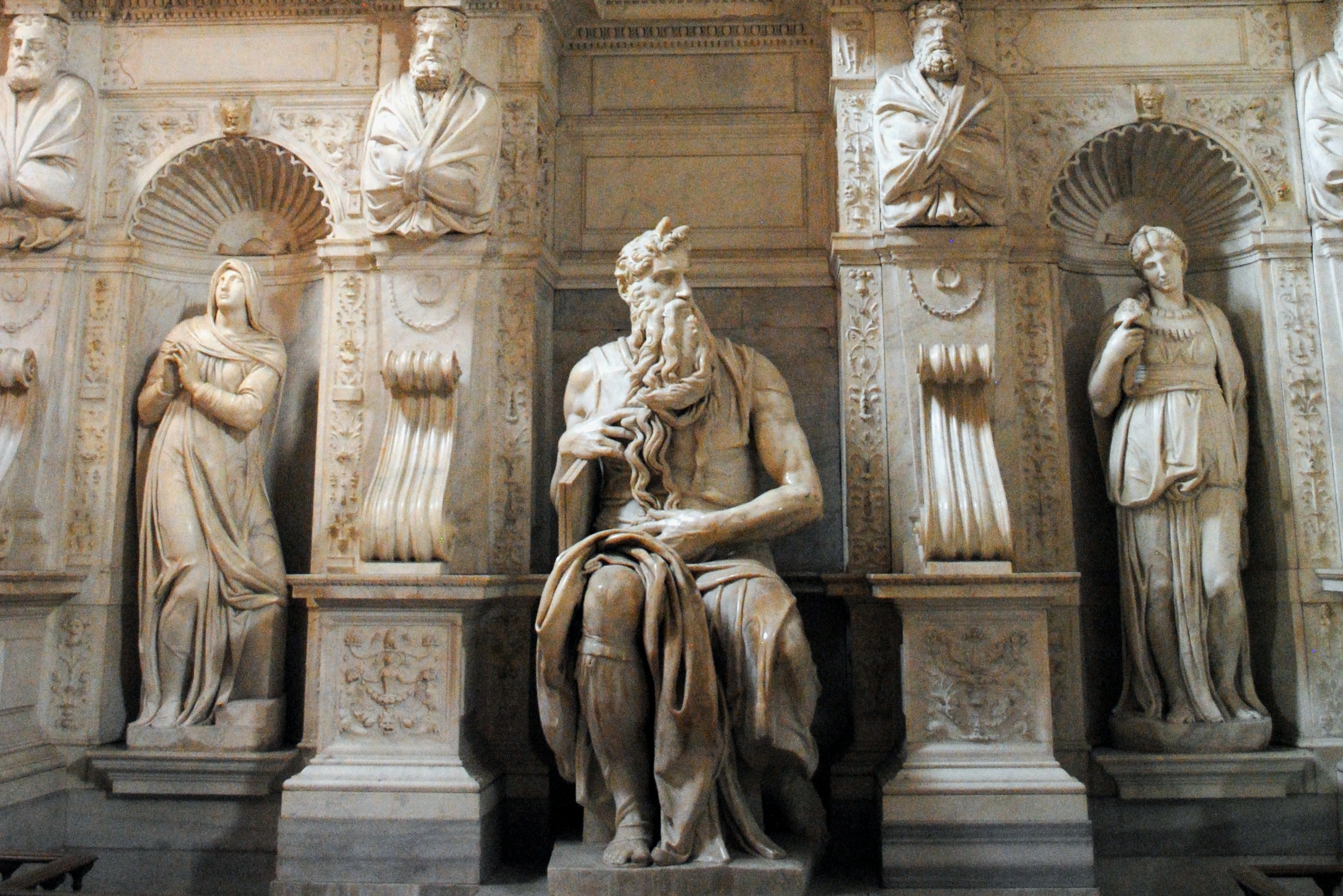 sent beams of light. And from Michelangelo’s perspective, a pair of horns was much easier to sculpt than a ray of light. The statue of Moses is flanked by statues of Jacob’s two wives, Leah and Rachel.
sent beams of light. And from Michelangelo’s perspective, a pair of horns was much easier to sculpt than a ray of light. The statue of Moses is flanked by statues of Jacob’s two wives, Leah and Rachel.
The Basilica also has other not-to-be-missed details such as the high altar with baldacchino at the front of the nave and two rows of ten massive columns flanking the nave that most likely were retrieved from an even older, ancient Roman temple on which the church was built. The vaulted ceiling of the church’s central nave also has some interesting 18th century paintings of various biblical scenes.
Basilica of St. Peter in Chains, Piazza di San Pietro in Vincoli, 4/A Rome.
Nearby wine-friendly restaurants include:
Hostaria da Nerone, Via Delle Terme di Tito, 96; phone: +39-06-4187-952.
This family-run, no-frills trattoria is in a relatively quiet area not far from the Colosseum. It has a small outdoor patio with a view of the Colosseum and menu stalwarts include traditional Roman dishes like amatriciana and pasta carbonara.
Enoteca Cavour 313, Via Cavour 313; phone:+39-06-678-5496; website: www.cavour313.it.
Enoteca Cavour is a convenient place to stop for a glass of wine after visiting the Basilica. You can snack on pasta, cheeses and salame or have a full meal. The wine list is enormous and includes wines from all over Italy as well as some French and other international selections.
Basilica of San Clemente (Basilica di San Clemente al Laterano)
The Basilica of San Clemente is dedicated to Saint Clement I, a Christian convert who later served as Pope in the last decade of the 1st century A.D. It is one of the oldest, best-preserved and most ornate of Rome’s medieval basilicas.
The Basilica dates back to the late 12th century. Like many of Rome’s existing churches and monuments it was built on the foundations of an earlier edifice, in this case a 4th century basilica that suffered extensive damage from the Norman invasion of 1084. This medieval church is, in turn, built on top the remains of a 1st century patrician Roman’s house and a nearby pagan temple to Mithras, the ancient Roman god of soldiers.
This is a multi-tiered architectural wonder, a contemporary church built on the remains of a much earlier church that, in turn, sits on top some ancient Roman ruins. It is an architectural time capsule dating from the Roman republic and the wonder of it is that you can visit all three levels for a layer-cake view of Rome’s history. Steps in the Basilica lead down to the 4th century basilica and from here another set of steps lead down to the dark remains of the ancient Roman villa and pagan temple.
The Basilica of San Clemente is one of Rome’s most ornate basilicas and worth a visit on its own. The nave and aisles of the church have gilded, coffered ceilings and are lined with paintings and statues from the 18th century when the church underwent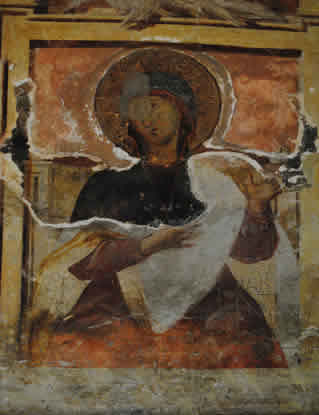 a substantial renovation. The ornate 12th century semicircular apse with its mosaic of the Triumph of the Cross is a wonder to behold. Doors at the far end of the nave lead to a peaceful, arcaded courtyard surrounded by low-rise convent buildings.
a substantial renovation. The ornate 12th century semicircular apse with its mosaic of the Triumph of the Cross is a wonder to behold. Doors at the far end of the nave lead to a peaceful, arcaded courtyard surrounded by low-rise convent buildings.
The nave of the lower 4th century Basilica features some frescoes from the early Christian era (see photo at left). From here, steps descend to the remains of the ancient Roman palazzo and a Mythraic stone altar that depicts the god sacrificing a bull.
Touring the Basilica of San Clemente offers a glimpse - albeit brief - of 2,000 years of Roman history.
Basilica of San Clemente, Via di San Giovanni in Laterano, 59/A Rome.
Nearby wine-friendly restaurants include the following:
Li Rioni, Via dei Santi Quattro, 24; phone: +39-06-7045-0605; website: www.lirioni.it
This small, inexpensive pizzeria-trattoria can get very busy so reservations are a must.
Aroma Restaurant, Via Labicana, 125; phone: +39-06-9761-5109; website: www.aromarestaurant.it.
The restaurant is located in the penthouse of the upscale Palazzo Manfredi and offers a birds-eye view of the Colosseum. The menu offers modern takes on Roman and Tuscan cuisine and a deep and broad wine list features some of Italy’s best offerings.
Naumachia Restaurant, Via Celimontana, 7; phone: +39-06-7002-764; website: http://www.naumachiaroma.com/en-gb/home.
Serves traditional Roman and Tuscan dishes and has a deep list of Italian wines.
Villa Farnesina
The Villa Farnesina is one is one of Rome’s historic and artistic treasures that flies under most visitors’ radar screens. Tucked away across the Tiber River in a charming area of Trastevere, the Villa is stunning but strangely doesn’t receive a lot of visitors. It truly is a gem hiding in plain sight.
Designed by the architect Baldassarre Peruzzi in the early 1500’s for the fabulously wealthy Sienese banker Agostino Chigi, the Villa is one of the masterpieces of the Renaissance. Surrounding the villa are beautiful formal gardens that are open for viewing by visitors.
But it is what’s inside that is truly eye-popping. Chigi spared no expense in furnishing the Villa and hired some of the most famous painters of the time to execute fresco paintings throughout the interior.
Room after room is chock-full of frescoes by artists such as Raphael Sanzio (aka Raphael), Sebastiano del Piombo, Giovanni da Udine, Giovanni Bazzi (aka il Sodoma), Giulio Romano, Gianfrancesco Penni and the architect/builder Baldassarre Peruzzi himself.
The frescoes are a visual feast for art lovers. Most of the frescoes depict secular or mythological scenes that provide a refreshing contrast to the somber religious paintings found thr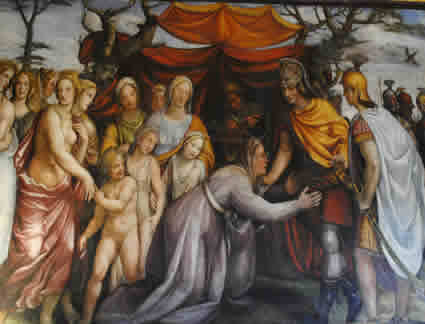 oughout Rome. The frescoes are simply stunning and, in contrast to most other art venues in Rome, you can view them at your leisure – visitors are sparse so you frequently have the galleries to yourself.
oughout Rome. The frescoes are simply stunning and, in contrast to most other art venues in Rome, you can view them at your leisure – visitors are sparse so you frequently have the galleries to yourself.
The photo to the right is of a fresco by Sodoma depicting Alexander the Great receiving the family of Darius.
Villa Farnesina - Via della Lungara, 230 Rome. For more information regarding hours and special exhibits visit Villa Farnesina’s website.
Nearby wine-friendly restaurants include the following:
Hostaria La Botticella, Vicolo del Leopardo 39/A; phone: +39-06-581-4738; website http://www.ristorantelabotticella.com/.
Small, cozy restaurant on a quiet side street that serves traditional Roman cuisine, some seafood and has a solid wine list with affordable offerings.
Osteria da Zi Umberto, Piazza di S. Giovanni della Malva 14; phone: +39-06-5816-646.
Zi Umberto is a friendly, informal osteria on a picture-perfect piazza in Rome’s charming but uber-touristy Trastevere area. It features classic Roman cuisine and is always bustling so reservations are a must for lunch and dinner.
©Richard Marcis
January 12, 2018
To view other travel itineraries in Italy, see Things to do and see in Italy

